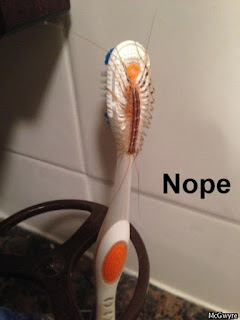Last weekend, while eating lunch at a local park, we had one of our geeky talks. The subject of which was:
What would happen if all living things died at once?
(This is a real photo of a herd of endangered saiga antelope, whose worldwide population dropped by half in just 14 days.
Learn more about their plight here.)
Not just plants and animals, but ALL living things: fungi, bacteria, worms, protists, everything. Your first thought might be one of repulsion, thinking of the nasty smell that would arise from all the simultaneous death. But here's where things get interesting. The smell of death, whether it be a deer, mushroom, human, fish, or leaves in your gutter, all is the product of decomposition, which is all done by living things, mainly, bacteria. As bacteria break down what was once living tissue, they release smelly gases, such as ammonia and sulfur compounds. And in our thought experiment, all bacteria have now ceased to exist. Other less odoriferous agents of decomposition, scavengers like vultures and coyotes and detritivores like millipedes, worms, mold, and mushrooms are also gone. This means that the dead matter will largely remain just as it is, in perpetuity, forever.
To ease our exercise a bit, let's say this mass extinction occurs now, in winter, and focus on the New Jersey woods where Mr. Nature Geek and I had this discussion. This means all the deciduous trees have lost their leaves and most annuals and perennials have died off. The ground is now covered in leaves, twigs, plants, and the bodies of animals. As the snow falls, drifts will form over these new elements of the terrain. As the snow melts and flows towards streams, rivers, and lakes, inevitably many of this dead plant and animal matter will make its way into these bodies of water. In smaller bodies of water, the extra material will cause enough displacement to notice a significant raise in water levels. (One may think that all the bodies/biomass of dead sea life may also cause sea levels to rise, but these plants and animals were already in the water and causing displacement, so there would be no change in that regard.) In rivers, there may be enough mass to cause jams and congestion in the water, altering the course of the river and causing massive floods. The floods cause new patterns of erosion and deposition, altering the landscape.
Without plants to withhold water in their roots, stems, and leaves, the water cycle on earth would be forever altered. The transpiration of water from plants is a huge part of the current water cycle on earth. Add to that water evaporating from the bodies of animals and other non-plants, and there would be a lot more free water on Earth. How would this affect the weather? Ocean levels?
Soils would also forever be changed. Soils are made of both organic (living or formerly living) and inorganic compounds (rock, clay, sand). Yes, leaves and such would still be in the soil, but without decomposition, they would not be broken down into small particulate, but remain as larger aggregate. Soils would change, but that would not affect much on this new lifeless planet, as there would no longer be any living things that would depend on the nutrient levels in soil.
This little thought experiment really got Mr. Nature Geek and I thinking about the impact that decomposition has in the health of our environment. Death and decomposition may be something that is feared and viewed as repulsive by humans, but it is an essential part of life on Earth. We owe our life to decomposers such as bacteria, fungi, insects, vultures, coyotes, and countless others. And in turn, they owe their lives to our deaths. We are all interconnected here on plant Earth, and that's a pretty geekily cool thought.




























